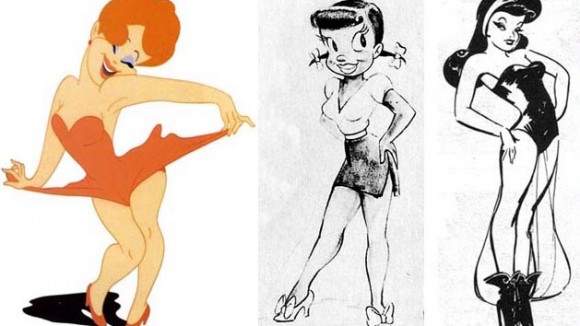

The Rise and Fall of the Funny, Sexy Cartoon Woman

Cartoon women are inherently difficult subjects for the animator for the reason that animation demands caricature and comedy, which are concepts inconsistent with femininity, grace and sensuality. The result is that when animators create female leads, they tend to de-emphasize cartoon qualities and accentuate realistic mannerisms and behaviors.
There was a brief moment in animation history when funny and sexy female characters were encouraged though, and that era coincided roughly with World War II. Some historians, like John Costello, have argued that the war represented the true beginnings of the sexual revolution in the United States. During the early-1940s, sexual imagery gained new visibility and cultural acceptance. Young soldiers lusted after Betty Grable and Rita Hayworth pin-ups, while reading Milton Caniff’s comic Male Call and decorating their bombers with provocative nose art. Within this liberal environment, Hollywood directors and animators took advantage of the opportunity to explore creative new ways of portraying the female character in animation.

A handful of animators, notably Pat Matthews, Preston Blair, Rod Scribner, Fred Moore, and Milt Kahl, became known for their ability to handle women characters that were true cartoon creations. Still, there were limited opportunities to animate such characters, and it wasn’t uncommon for animators to use male characters in drag as a substitute for the female, such as Daffy Duck’s striptease in The Wise Quacking Duck (1943), animated by Art Babbitt.
The sexy cartoon female occasionally appeared in animation after the war, but by and large, the industry began to favor a blander and less cartoon-influenced style. By the early-1960s, the average cartoon female in Hollywood animation had become so unappealing that Rocky and Bullwinkle co-creator Bill Scott quipped, “The way women are drawn in our business today, one would assume all the artists are fags.”
The following selection of animated films illustrate some of the various approaches to the animated female character during the World War II period:
“Eatin’ on the Cuff” or The Moth who Came to Dinner (Warner Bros, Bob Clampett, 1942)
Coal Black and de Sebben Dwarfs (Warner Bros, Bob Clampett 1943)
Red Hot Riding Hood (MGM, Tex Avery, 1943)
Abou Ben Boogie (Walter Lantz Prod, Shamus Culhane, 1944)
Plane Daffy (Warner Bros, Frank Tashlin, 1944)
Duck Pimples (Disney, Jack Kinney, 1945)
